New Buoy Markers To Be State-Of-The-Art
BY
SUSAN T. HERRING, Editor, The Guardian-Journal
New permanent buoy markers were
the main 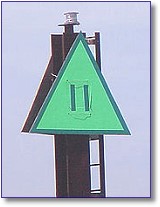 topic of discussion at the special meeting of the Claiborne Parish
Watershed District Commission last week. Chic Hines, who heads up the Permanent
Marker Committee for the Commission, presented a set of specifications for
approval and asked for permission to begin advertising for bids.
topic of discussion at the special meeting of the Claiborne Parish
Watershed District Commission last week. Chic Hines, who heads up the Permanent
Marker Committee for the Commission, presented a set of specifications for
approval and asked for permission to begin advertising for bids.
Hines said for years the
Commission has battled the present floating buoy system. It has been hard to
maintain using volunteer labor, since buoys consistently drift all over the
lake due to high water, high wind, or from people moving them. The remedy is to
drive permanent pilings to mark the channel and the creeks.
Alice Stewart said, “This is
the first step in making Lake Claiborne a first class lake; something
we can be proud of.”
The new buoy markers will be
state-of-the-art and could be in place by the end of the year. The plan consists
of permanently installing 196 new treated pilings in strategic areas around the
lake and retrofitting 29 existing pilings located in the Lisbon landing area. Each piling will
slope to provide self-cleaning. Markers will be numbered and each will have a
lighted top. Markers in each channel will have a different flashing pattern to
assist boaters at night. There will be 122 red daymarker signs and 136 green
daymarker signs.
All entrances will show creek
names. Buoy markers will also note “danger” and “no wake” zones. Each piling
will be numbered and recorded with a GPS (global position system) and will have
a 360 degree reflective band at the top. All specifications meet Inland Water
Coast Guard regulations.
The project, estimated to cost between $400,000-$500,000, will improve boating safety on
the lake and provide economic benefit by extending the usage time of the lake.
Attorney Jim Hatch is reviewing
bid specs now to make sure they meet all legal requirements. Once
finalized, big packages will be prepared. Commissioners approved
advertising for bids, with the understanding they
might delay advertisement to apply for federal grant funds.
Bids will be advertised for
advertise three weeks. Once the locations for the poles are determined using
GPS this fall, it will take about four months to complete the project.
The Commission approved a
resolution requesting the Louisiana Wildlife and Fisheries seek approval to drawdown Lake Claiborne 2-3 feet after Labor
Day for the purpose of determining appropriate placement of markers using the
global position system.
Mark McElroy, biologist with
LWF, suggested the Commission submit grant applications for the marker project
not to exceed $300,000, as well as for improvements to the Arizona landing. If commissioners
decide to apply for the grant, installation of markers could be delayed until the
Spring of 2008.
…more
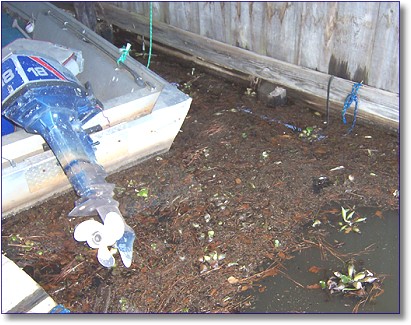
Water Hyacinth, a free-floating
plant with thick, waxy leaves, has been spotted in recent months in the upper
end of Lake
Claiborne
off Airport Loop. Without treatment, populations can double in 12 days. Besides
blocking boat traffic, they interfere with swimming and fishing. Infestations
prevent sunlight and oxygen from getting into the water and can reduce
fisheries. La. Wildlife and Fisheries plans to treat identified areas this
spring.
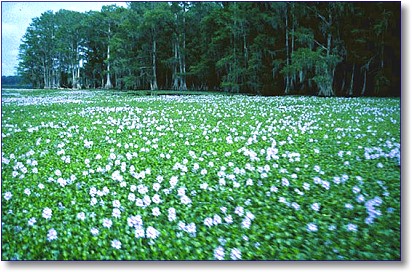
Water Hyacinth is one of the worst
weeds in the world—aquatic or terrestrial. Until only a few years ago, this
floating plant was a major problem in Florida covering as
many as 125,000 acres of water. Boat traffic on several rivers was halted.
Hundreds of lakes and ponds were covered from shore to shore with up to 200
tons of hyacinths per acre, pictured here. The problem in Florida has since
been mitigated.
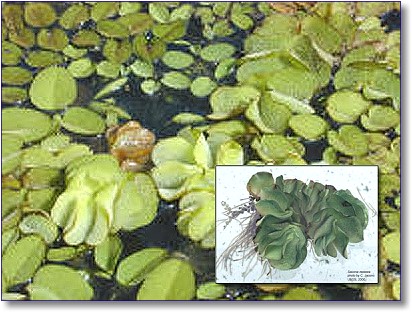
Giant Salvinia is a fern with no
flower. Floating leaves on a mature plant have a distinct midrib that may fold
forming a chain-like appearance. So far, none has been sighted on Lake Claiborne.
As of January 2007, it had been seen on 8 of 13 lakes in NW Louisiana. It is
illegal to be in possession of the plant, so boaters should inspect inside and
outside boats for any plant material before leaving boat ramps. Call 371-3050
to report sightings.
Water Hyacinth Spotted On Lake
BY
SUSAN T. HERRING, Editor, The Guardian-Journal
Floating aquatic weeds seen
floating on the upper end of Lake Claiborne near Lisbon landing and the Airport Loop
in recent months has been identified as water hyacinth. Although water hyacinth
is described as one of the worst weeds in the world—aquatic or terrestrial,
giant salvinia is considered a bigger threat to the waters in Louisiana.
Water hyacinth as an invasive
exotic plant found mainly in large water areas in Louisiana. 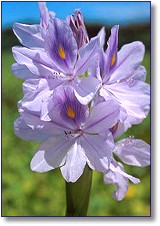 The free-floating plant has
thick, waxy leaves. Leaf stalks are bulbous and spongy and grow to 20 inches
long with a single spike of several purplish blue or lavender flowers.
Populations can double in 12 days. Besides blocking boat traffic, they can
interfere with swimming and fishing. Water hyacinth infestations prevent
sunlight and oxygen from getting into the water and can reduce fisheries.
The free-floating plant has
thick, waxy leaves. Leaf stalks are bulbous and spongy and grow to 20 inches
long with a single spike of several purplish blue or lavender flowers.
Populations can double in 12 days. Besides blocking boat traffic, they can
interfere with swimming and fishing. Water hyacinth infestations prevent
sunlight and oxygen from getting into the water and can reduce fisheries.
When not controlled, water
hyacinth will cover lakes and ponds entirely; dramatically impacting water
flow, blocking sunlight from reaching native aquatic plants, and starving the
water of oxygen. Until a few years ago, this floating plant was a major problem
in Florida covering as many as 125,000 acres of water. Boat traffic
on several rivers was halted. Hundreds of lakes and ponds were covered from
shore to shore with up to 200 tons of hyacinths per acre. The problem in Florida has since been mitigated.
Water hyacinth is easily
treatable and fairly easy to get under control in the early stages. The
Louisiana Wildlife and Fisheries District One office is planning to send a crew
in the spring to treat the water hyacinths that have been identified on Lake Claiborne.
In September 1998, giant
salvinia was discovered on the Louisiana side of the Toledo Bend
Reservoir. As of January 2007, the plant had been found in 8 of 13 lakes
routinely sampled by the LWF District 1 office. Those lakes are Cross Lake, Caddo Lake, Lake Bistineau, Clear-Smithport Lake in Carmel, Grand Bayou Reservoir in
Coushatta, Wallace Lake and Black Bayou Lake in Caddo Parish, and parts of Red River. According to Jeff Sibley,
Biologist Supervisor for District 1, no giant salvinia has been spotted on Lake Claiborne so far.
Giant salvinia is a fern and
has no flower. The floating leaves are oblong with a distinct midrib along
which the leaf may fold forming a compressed chain-like appearance. It forms
dense mats and can double in size in a few days.. Up
to two feet thick, mats can cover the surface of an entire pond or small lake,
blocking sunlight, ruining conditions for fishing, boating, or waterskiing.
This plant can establish itself
in a new water body from one small fragment. Since it is illegal to be in
possession of the plant, boaters should always inspect the inside and outside
of their boat and trailer for any plant material before leaving the boat ramp.
Sibley said Lake Claiborne, in general, has little
vegetation problems. One reason is the deep contours in the lake, since most aquatic
plants such as hydrilla and alligator weed grow in shallow water, about six
feet deep where sunlight can penetrate the bottom, usually around the
shoreline. Landowners are encouraged to physically remove these type plants
when the lake is down. Without treatment, however, even floating plants such as
water hyacinth and giant salvinia can present a problem even in deep lakes.
Persons are urged to report
sightings of aquatic plants to the Minden office. Due to lack of
manpower and time constraints, however, LWF may not be able to treat every
area. Owners of private ponds can also report sightings of aquatic plants to
the LWF. Since LWF can only treat public water bodies, Sibley will only be able
to provide information to property owners so they can contact a consulting
business that can handle applications on private land.
To contact Sibley at the LWF
office in Minden, call 371-3050.
Woman Mugged, Juvenile
Arrested
Homer Police officers arrested
a 15-year-old juvenile after he knocked an elderly lady down in front of Piggly
Wiggly in an attempt to take her purse. A 73-year-old Homer woman was exiting
the store about 4:30 PM on Friday, January 19 when she was approached by two
young black males. As she was speaking to them, one tried to snatch her purse
causing her to fall to the sidewalk and injuring both elbows, her left forearm
and hip.
Homer Police officers J. D.
Faulkner, Norah Banks, and John Bailey were dispatched to the scene. The lady
gave a detailed description of the two males, one who was wearing glasses. She
told officers they ran in the direction of the old Coca-Cola plant on East 3rd Street. Officers canvassed the area
looking for the subjects.
Following an investigation,
Homer Police Chief Russell Mills and Officer Faulkner arrested one juvenile
Wednesday morning, January 24, at the alternative school on the Homer High
campus. The other juvenile was questioned and released.
On Friday, January 26, District
Judge Jenifer Clason granted a continued stay in juvenile court. The youth was
then transported back to the Ware Youth Center in Coushatta where he will
await his next court date.
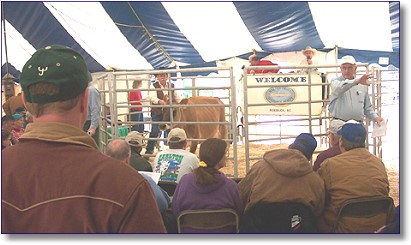
The Hill Farm Research Station
was first established by legislative act in 1946. At that time, the
“Experimental Station” conducted research on agricultural, livestock, and tree
crop practices. Initial research included dairy and poultry. Over the years,
things changed. A Mastitis Research Laboratory was built in 1968 when Dawson M.
Johns was superintendent (1947-1980). It was expanded in 1985. Last week things
changed again. All 189 dairy cows were sold at auction. According to Dr. Allen Nipper, Regional
Director, future research will focus on poultry, timber, and beef cattle.
Hill Farm Auction Draws
Bidders From 8 States
BY JIMMY DEAN, Feature Writer, The Guardian-Journal
Walking to the big blue and
white tent, bovine ordure requires that I watch where I step. I’m reminded of
tent revivals from the 1950s with their melodic glossolalia. Inside this tent,
however, it is Jim Towns’ rapid-fire cadence as he rips
through his bid-chant.
Today, Wednesday, January 24
has drawn dairy cattle buyers from eight states to Claiborne Parish’s Hill Farm
at the intersection of Highways 9 and 79. Row after row of pickups with cattle
trailers fill the parking area, some spilling out along the highways.
Getting completely out of milk
production research, the Hill Farm is selling almost 200 animals. According to Lewis Harrison, owner of Walnut Grove Auction out of South
Carolina.
Harrison advises me later that one
buyer traveled almost 1500 miles from Wisconsin and is the winning bidder for
the load of dairy cattle he bought. Another bidder has come almost 1000 miles
from North Carolina and purchases several head. A
total of 189 animals will be sold today.
The tent is so full that many
are standing. A couple of ring men move around the floor of the auction
spotting bids and encouraging bidders not to let a deal get away. Although I
have no interest in buying anything, the bidding enthusiasm is contagious.
Thankfully, I don’t go home with a heifer.
The reason for the sale,
according to Dr. Allen Nipper, Regional Director, is that the Hill Farm is
redirecting their research efforts toward poultry, timber, and beef cattle. “We
may lose four positions as a result of this change in focus; however, other
positions may open as a result of this shift in direction,” he says.
Harrison mentions that the nation’s
dairy industry is being hurt by imports, “mostly dairy by-products such as
butter and cheeses. The dairy industry has experienced a 50% reduction in the
past 30 years, mostly due to foreign imports.”
The smell of freshly cooked
ground beef draws hungry bidders to the Arcadia 4-H Livestock Club’s table
with the makings for burgers along with soft drinks. A student says the club
tries to make area events such as this to raise money for club projects. When
asked how the fundraising is going, a teacher says, “Very good!”
Back home, I’m glad I didn’t
give in to auction fever. There’s just ain’t enough room in the backyard for a
heifer to graze....
LSU
AgCenter Hires Poultry Agent
The LSU AgCenter is pleased to
announce the addition of Johnnie Gale Whitmire as Assistant Extension Agent for
poultry management. Ms. Whitmire will
serve the poultry producing areas of north Louisiana 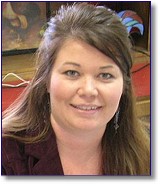 by implementing educational
programs related to management dealing with brooding, feeding, watering,
ventilation, litter management, and dead bird disposal. She will deliver research based information
to poultry growers in group meetings and on-farm visits. In addition, she will be responsible for the
management of new broiler houses recently built on the Hill Farm Research
Station south of Homer. The houses will
be used for demonstration / educational purposes to help growers understand how
house conditions related to management issues can affect their profitability
and efficiency and to provide a training facility for poultry company field
representatives.
by implementing educational
programs related to management dealing with brooding, feeding, watering,
ventilation, litter management, and dead bird disposal. She will deliver research based information
to poultry growers in group meetings and on-farm visits. In addition, she will be responsible for the
management of new broiler houses recently built on the Hill Farm Research
Station south of Homer. The houses will
be used for demonstration / educational purposes to help growers understand how
house conditions related to management issues can affect their profitability
and efficiency and to provide a training facility for poultry company field
representatives.
Originally from Baton Rouge, Johnnie graduated from Mississippi State University with a B.S. in Poultry
Science. Her interest in poultry began
on her family’s breeder farm while she was in high school. Her first internship in college was with
Sanderson Farms hatchery in McComb, Mississippi. After college she worked extensively for the
last twelve years in poultry processing, broiler management, feed production,
hatcheries, and equipment sales. Her
industry experiences have included a one year management trainee program with
Tyson Foods in their Gadsden, Alabama processing plant. Later she worked for ConAgra Poultry (now
Pilgrim’s Pride) as a broiler field representative and in feed mill production
and scheduling in Alabama and Georgia. Most recently, she was employed by Georgia
Poultry Company/Hogslat in poultry equipment sales.
Ms. Whitmire will be a part of
the AgCenter’s North Central Region faculty, and her office is at the Hill Farm
Research Station. She can be reached at
318-927-2578 or via email at jwhitmire@agcenter.lsu.edu.
Clementine Hunter Exhibit To Open February 15 At Museum
The Art and Social Commentary
of Clementine Hunter is comprised of more than 20
images of works by the artist. The exhibit, which will be on display at the Herbert S. Ford Museum in Homer from February
15-April 20, captures the spirit of Hunter’s life and work. As with most folk
artists, Hunter’s art reflects the tragedies and triumphs of a simple and
unadorned lifestyle. Her work depicts exactly what she knew, the agrarian
existence of life on Melrose Plantation and the small traditions and ceremonies
that mark a person’s progression from birth to death. For information on the
primitive art workshop to be conducted by local artist Chris Broussard on
Monday, February 26, call 927-9190.
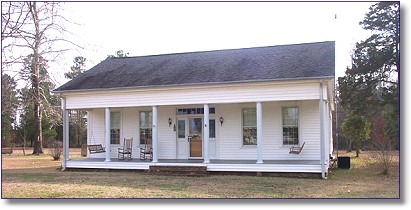
Reginald and Robbie Allgood
of Summerfield transformed their home built in the 1880s into a rustic but
comfortable residence.
Allgood House In Summerfield: Another Jewel
BY
JIMMY DEAN, Feature
Writer, The Guardian-Journal
Draped around Claiborne Parish like a
sparkling necklace are many gems: the Courthouse, Lake Claiborne, Ford Museum, the Alberry Wasson Log House,
the Killgore House...
Another is the Allgood house in
Summerfield, built about 1886 by Dr. William Sellers. “It may have been earlier
because we found in the walls of the house some old letters to Dr. Sellers that were dated in
1884,” Reginald Allgood recalls. “We also found other things in the walls: old
newspapers, an old tea set, and an English grammar book signed 1872.” The house
was acquired about 1910 from Mary Ledbetter by Dr. Joseph C. Allgood,
Reginald’s grandfather.
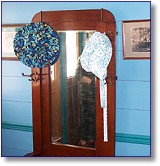 Employed by Monsanto, Reginald
lived with his wife Robbie in Luling the first 35 years of their marriage. When
he retired in 1990, they moved back to Summerfield and with the help of Robert
Earl Smith began restoring the house, a project that would take 5-6 years.
Employed by Monsanto, Reginald
lived with his wife Robbie in Luling the first 35 years of their marriage. When
he retired in 1990, they moved back to Summerfield and with the help of Robert
Earl Smith began restoring the house, a project that would take 5-6 years.
With a wide porch stretching
across the front, the house was originally built dogtrot style with an open
hallway down the middle. The dogtrot has become an entrance hall just inside a
door flanked by side windows. Now enclosed, the entryway is accented with
pictures and furniture reminiscent of the early 1900s. For example, Robbie has
draped the hall tree just inside the door with a bonnet and floral sunhat.
To the left of the entry area
is a dining room with ceiling and wall treatments that add provincial flavor to
the room. From the white ceiling hangs the dining room light, the base of which
is painted with a faux medallion of concentric circles of blue, gray, pink, and
green surrounding another circle of red stars. The breakfront
as well as pictures from the early 1900s all contribute to the room’s
rustic flavor.
Back across is the front
bedroom, its decor evocative of an earlier age. Wide-planked walls painted pink
have an interesting treatment near the ceiling. Robbie refers to it as “train
wheels” because circles have been painted to resemble train wheels. The
colorful quilt on the double bed enhances the room’s bygone-era flavor.
Reginald and Robbie take us
from the nineteenth century back to the twenty-first as we tour the rest of the
house with its contemporary comfort.
Allgood House proves that
classic beauty plus modern amenities equal timeless treasure.
-0-0-0-
“...old buildings
are important in maintaining a sense of history and place...their preservation
is important for community continuity and identity.”—www.brunerfoundation.org
Looking Back—More
Highlights From 2006
Continued from last week....
MAY
M/Sgt. Scott Cottrell at David Wade Correctional Center was named Louisiana
Correctional Officer of The Year for 2005 at an Employee Awards Ceremony held
in May.
Ron Anderson, director for the
Claiborne Boys and Girls Club, submitted his resignation May 30 after being on
the job less than 8 months. . …more



